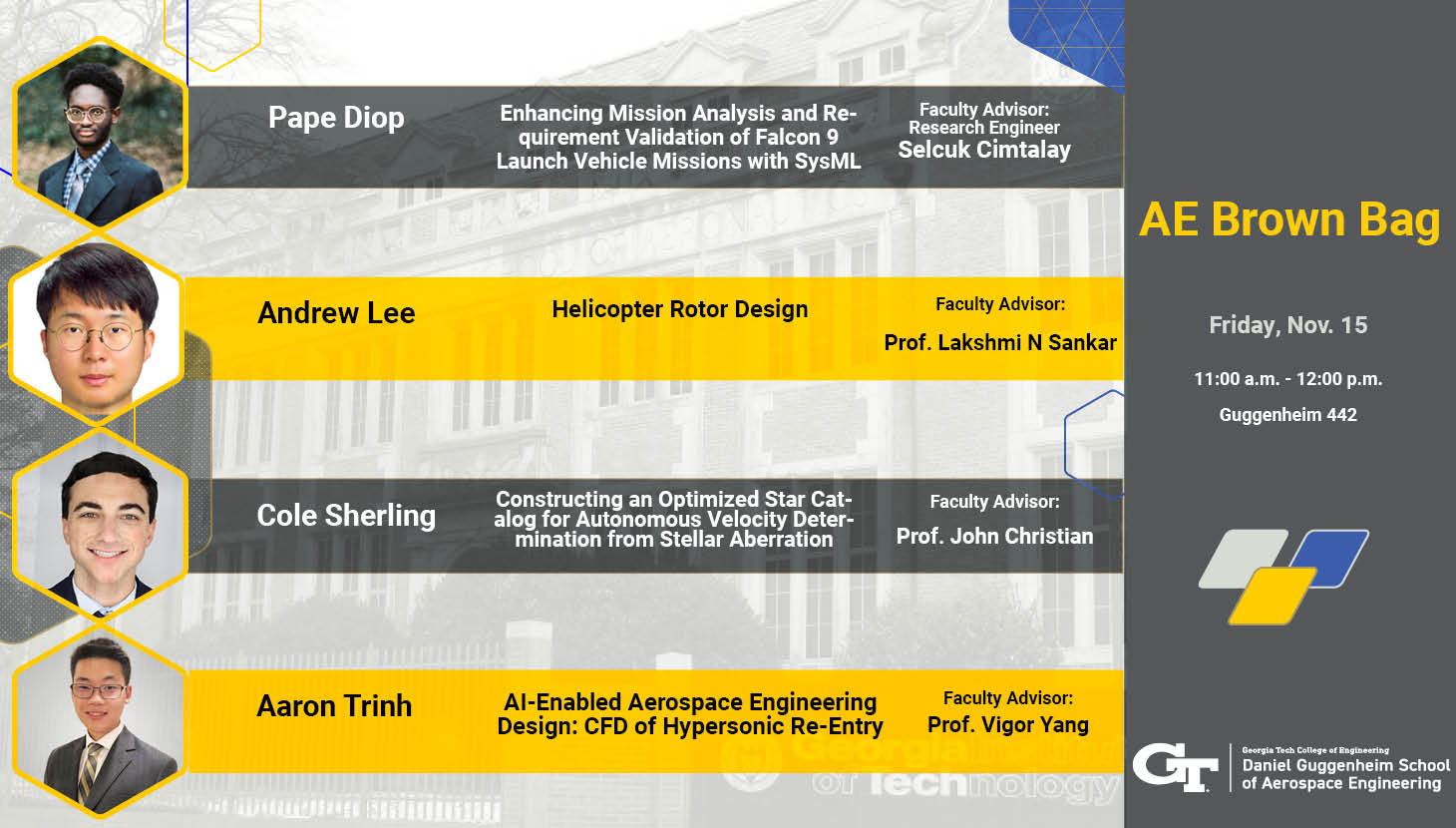
AE Brown Bag Seminar
Friday, November 15
11:00 a.m. -12:00 p.m.
Guggenheim 442
Pizza Served
Pape Diop
Andrew Lee
Cole Sherling
Aaron Trinh
Pape Diop
Title:
Enhancing Mission Analysis and Requirement Validation of Falcon 9 Launch Vehicle Missions with SysML
Abstract:
With the rapid growth of the space industry in recent years, there has been an increase in the number of stakeholders that are involved in the launch vehicle missions carrying various payloads. To ensure consistent mission success, it is essential to ensure clear and concise communication between the parties involved to avoid the occurrence of errors that can serve as a detriment to the overall mission objective. An SysML model of a Falcon 9 launch vehicle, carrying out an SES-10 satellite mission, was developed to demonstrate how MBSE can enhance the communication of information and reduce mission risk through detailed modeling. MagicDraw will be used to develop a component architecture of the Falcon 9 launch vehicle and integrate MATLAB to conduct an analysis of the performance parameters. A Graphic User Interface (GUI) diagram will then be used to enable the dynamic input and output of these parameters and be tied to requirements for immediate validation. Through creating a user-interactive method of conducting requirement validation and mission analysis, the model demonstrates how SysML can minimize mission risk and improve requirement traceability by enabling real-time feedback on system performance.
Faculty Advisor:
Dr. Selcuk Cimtalay
Andrew Lee
Title:
Helicopter Rotor Design
Abstract:
Given a rotor geometry, a new airfoil with a lower drag characteristic was computed with the power consumption varying with blade pitch angle, and its RPM. Various factors were considered to see if performance could be improved.
Faculty Advisor:
Professor Lakshmi N Sankar
Cole Sherling
Title:
Constructing an Optimized Star Catalog for Autonomous Velocity Determination from Stellar Aberration
Abstract:
There is interest in the development of autonomous navigation methods for spacecraft, especially in deep space where there is no GNSS and ground-based ranging services are expensive and limited in capacity. StarNAV is one such method currently in development, taking advantage of stellar aberration, or the perturbation of a star's observed direction due to special relativity. By comparing three or more interstar angles measured by a star tracker on a spacecraft to those observed by a stationary observer relative to the solar system barycenter, the spacecraft's velocity can be computed. However, this method requires an astrometric measurement error of less than 1 milliarcsecond, and not all stars and star pairs can meet this requirement with current technology and astrometric knowledge. Luckily, since the astrometric error is well-quantified, the ideal star pairs for measuring stellar aberration can be precomputed. This presentation discusses the implementation of algorithms to construct a quickly traversable data structure containing the reference IDs of the ideal star pairs for many evenly spaced reference directions, as well as the methods and criteria for deciding which star pairs are most ideal for velocity determination.
Faculty Advisor:
Professor John Christian
Aaron Trinh
Title:
AI-Enabled Aerospace Engineering Design: CFD of Hypersonic Re-Entry
Abstract:
The advent and recent explosion of AI in the tech industry presents a new way of approaching problems – asking a neural network-trained computer model to complete tasks or generate ideas for humans. Much research, such as with Physics-Informed Neural Networks (PINN), has been conducted in attempting to use AI in the engineering design process with the hopes of obtaining physically valid results, but these efforts have been met with lackluster success. The goal of my research is to train and utilize a novel AI technique dubbed “Neural Network with Local Converging Inputs” (NNLCI) developed by Dr. Yang’s research group, which can predict the outcomes of physics models more accurately than PINN, to predict the results of hypersonic CFD simulations.Ultimately, NNLCI aims to accurately survey an nth-dimension engineering design space and perform automated design parameter optimization. The presentation will include an in-depth discussion on the design parameter(s) at hand, specific modeling criteria, and preliminary CFD results which will be used as high-fidelity training data for NNLCI.Faculty Advisor:
Professor Vigor Yang